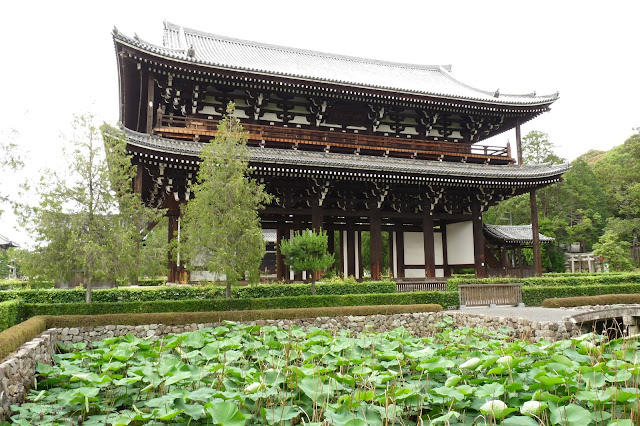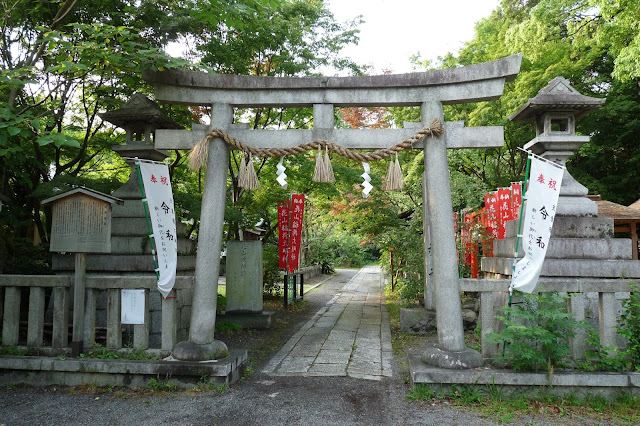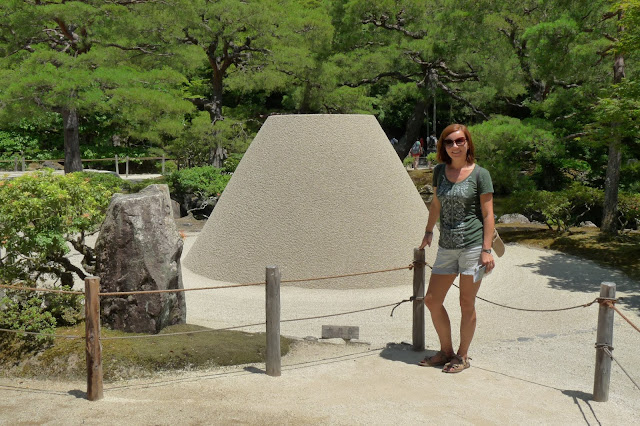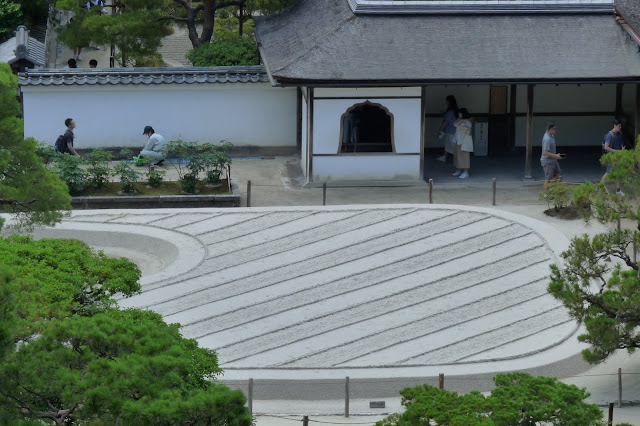Japanin huippukaupungit - The Highlights of Japan: Kioto & Osaka
Japani oli tarjonnut meille jo lukuisia huippukohtia, kuten huumaavan Tokion ja saaren keskiosan hurmaavat kaupungit Matsumoton, Takayaman ja Kanazawan. Japanin suosituin matkakohde odotti meitä kuitenkin vielä kaikessa komeudessaan: Kioto, jossa vietimme kolme väsyttävää, mutta todella palkitsevaa päivää.
Japan had already offered us several highlights, such as the intoxicating Tokyo and the lovely towns of Matsumoto, Takayama and Kanazawa in the middle of the island. However, the most popular tourist destination of Japan awaited us with all its glory: Kyoto, where we spent three tiring, but totally rewarding days.
Kioto on niin täyteen tupattu huikeita nähtävyyksiä, että sen kokemiseen tarvitaan jonkinlainen suunnitelma. Me jaoimme nähtävyydet suunnilleen ilmansuuntien mukaan, jotta pääsimme kohtalaisen vähäisellä vaivalla paikasta toiseen kohtuuhintaisella bussipäivälipulla (600 jeniä eli alle viisi euroa per päivä). Aloitimme keskikaupungilta, läheltä hotelliamme, vierailemalla Nijo-linnassa (pääsymaksu 600 jeniä per henkilö) ja keisarillisen palatsin puistossa, jossa sai samoilla ilmaiseksi. Nijon linna oli todella hieno, harmi vain ettei sisätiloissa saanut ottaa kuvia.
Kyoto is so full of amazing sights, that you really need a game plan to make the most of it. We divided the sights by the direction, so that we could get relatively easily from one place to another with the help of the great-value bus pass (600 yens or less than 5 euro per day). We started off at downtown, close to our hotel, by visiting the Nijo Castle (600 yens per person) and the imperial palace and park, where you could visit for free. Nijo Castle was really impressive, it's a shame you cannot take pictures inside.
Kaupungin eteläpuolella suuntasimme ensimmäiseksi Fushimi Inari -pyhättöön, joka tunnetaan erityisesti tuhansista torii-porteistaan. Pyhätön alueelle pääsee ilmaiseksi, ja sieltä voi lähteä kävelemään porttien reunustamaa polkua pitkin metsän keskelle. Paikka on todella kaunis ja vaikuttava, ainoa ongelma oli valtavat ihmismassat, jotka parveilivat joka puolella. Mitä pitemmälle polkua pitkin etenimme, sitä vähemmän porukkaa siellä oli, joten loppuvaiheessa pystyi jo ottamaan joitain kuvia ilman muita ihmisiä. Kohtuullisen lähellä oli seuraava kohteemme, Tofukuji-temppeli (400 jenin pääsymaksu). Tämä on yksi Kioton vanhimmista ja tunnetuimmista temppeleistä, joka on suosittu käyntikohde etenkin syksyllä ruskan aikaan - temppelin puutarhan vaahterapuut nimittäin näyttävät mahtavilta ruskan aikaan. Me olimme siellä keskikesällä, joten ruskasta ei tietoakaan - joka tapauksessa temppelin alue oli kaunis ja huomattavasti Fushimi Inarin aluetta rauhallisempi.
On the South side of the town we headed first to the Fushimi Inari Shrine, which is particularly famous for its thousands of torii gates. You can enter the shrine area for free, and keep walking along the path lined by the gates through the forest. It's a wonderful place, the only problem was the enormous crowds that took over the whole area. The further up the path we walked, the less people there were, so finally we were able to take some pictures without other people in them. Our next destination, Tofukuji Temple (entrance fee 400 yens) was relatively close by. This is one of the oldest and most famous temples in Kyoto, which is particularly popular in the autumn - the maple trees of the garden look amazing in their autumn foliage. We were there in the middle of the summer, so no sign of autumn foliage, but in any case the temple area was beautiful and considerably more quiet than the Fushimi Inari.
Kioton pohjoispuolelta löytyy Kultainen paviljonki eli Kinkakuji-temppeli, joka on kerrassaan huikea näky lammen yli katsottuna. 400 jenin pääsymaksulla saa kierrellä temppelin aluetta, joka oli viehättävä - joskin täynnä ihmisiä. Kivipuutarhastaan tunnettu Ryoanji-temppeli (500 jenin pääsymaksu) sen sijaan jätti meidät vähän kylmäksi - olihan kivinen puutarha ihan jännä, mutta ei mielestäni läheskään yhtä vaikuttava kuin muut tähän asti näkemäni Kioton nähtävyydet. Daitokujin temppelialueelle ehdimme sen verran myöhään iltapäivällä, että kaikki temppelit olivat jo kiinni. Ei se mitään, se tarkoitti, että saimme kuljeskella ihan kahdestaan tunnelmallisella alueella, ilman Kioton joka nurkkaa vaivaavia väkimassoja.
The North side of Kyoto is where you find the Golden Pavillion or Kinkakuji Temple, which is an absolutely magnificent sight reflected on a large pond. The entrance ticket of 400 yens gets you in to walk around the temple area, which is lovely - although very crowded. However, our next destination - Ryoanji Temple (entrance ticket 500 yens) known for its rock garden - left us a little underwhelmed. Sure, the rock garden was pretty neat, but in my opinion not nearly as impressive as the other sights we had so far seen in Kyoto. We only made it to the Daitokuji Temple Complex in the late afternoon, when all the temples had closed already. That was fine though, as this way we could be strolling the atmospheric area by ourselves without the crowds that otherwise plagued every corner of Kyoto.
Kaupungin länsiosassa on huikea Arashiyaman bambumetsikkö, jonka upeutta on vaikea sanoin kuvata, eivätkä kuvatkaan tee sille oikein oikeutta. Bambujen lomassa saa kuljeskella ihan ilmaiseksi, mutta mitään rauhaa ja hiljaisuutta ei kannata odottaa - väkimassoja on nimittäin täälläkin ihan kiusaksi asti.
On the West side of the town there is the incredible Arashiyama Bamboo Grove, which is difficult to describe and even the pictures don't really do justice to this amazing place. You can visit the bamboo grove for free, but you cannot expect much peace and quiet though - also this place is very, very crowded.
Vielä ehdimme Kioton itäpuolelle tutustumaan pariin temppeliin: Ginkakuji-temppeliin, joka tunnetaan myös Hopeisena paviljonkina (vaikkei se olekaan hopeinen). Pääsymaksu oli 500 jeniä, ja sillä sai kierrellä temppelirakennusten alueella. Kohokohtia olivat sammalpuutarha ja huikea hiekkapuutarha, jossa hiekasta muotoillut tötteröt pysyvät koossa jonkinlaisen ihmeen avulla. Viimeinen temppelimme oli Nanzenji-temppeli, jonka alueelle pääsi ilmaiseksi, ja halutessaan saattoi maksaa pääsymaksun erillisiin temppelirakennuksiin.
We still had time to visit the East side of Kyoto to see a couple more temples: Ginkakuji Temple, also known as Silver Pavillion (despite the fact that it is not made of silver). By paying the entrance fee of 500 yens you could visit the whole temple area. The highlights included a moss garden and the amazing dry sand garden, where cones made of sand seemed to be held together by some sort of a miracle. The last temple we visited in Kyoto was Nanzenji Temple, whose grounds are free to enter, and you can pay separate entrance fees to individual temples.
Kiotossa vietetyt päivät olivat siis yhtä intensiivisista nähtävyyskierrosta, joten Osakassa otimmekin huomattavasti iisimmin. Vierailimme kauniissa Osakan linnassa (pääsymaksu 600 jeniä) ja teimme päiväretken junalla Naraan, jonka kesyt peurat ovat yksi vetonaula. Lisäksi kaupungista löytyy toki buddhalaisia temppeleitä, kuten valtavasta Buddha-patsaastaan tunnettu Todaiji-temppeli. Harmi sinänsä, että koko päivän satoi kaatamalla vettä, mikä teki puistossa kulkemisesta vähemmän mukavaa. Muuten Nara oli kyllä kiva paikka, ja ehdottomasti käymisen arvoinen!
As our days in Kyoto were filled with rather intensive sightseeing, we took it a lot easier in Osaka. We did visit the lovely Osaka Castle (entrance fee of 600 yens) and did a day trip to Nara, known for its tame deer. Apart from the deer, there are of course Buddhist temples, for example the Todaiji Temple, famous for its huge Buddha statue. Unfortunately it was raining absolutely all day while we were in Nara, which made strolling in the park less pleasant. Otherwise Nara was really lovely though, and definitely worth a visit!
Osakasta lensimmekin sitten seuraavaan kohteeseemme - jätimme viimein Aasian taaksemme ja suuntasimme maailman kaukaisimpaan kolkkaan eli Havaijille!
Osaka was our last destination in Japan, and from here we flew to our next destination - we were finally leaving Asia behind and heading to the most remote island group on Earth: Hawaii!
Japan had already offered us several highlights, such as the intoxicating Tokyo and the lovely towns of Matsumoto, Takayama and Kanazawa in the middle of the island. However, the most popular tourist destination of Japan awaited us with all its glory: Kyoto, where we spent three tiring, but totally rewarding days.
 |
| Gina with the local delicacy: takoyaki or octopus balls |
Kioto on niin täyteen tupattu huikeita nähtävyyksiä, että sen kokemiseen tarvitaan jonkinlainen suunnitelma. Me jaoimme nähtävyydet suunnilleen ilmansuuntien mukaan, jotta pääsimme kohtalaisen vähäisellä vaivalla paikasta toiseen kohtuuhintaisella bussipäivälipulla (600 jeniä eli alle viisi euroa per päivä). Aloitimme keskikaupungilta, läheltä hotelliamme, vierailemalla Nijo-linnassa (pääsymaksu 600 jeniä per henkilö) ja keisarillisen palatsin puistossa, jossa sai samoilla ilmaiseksi. Nijon linna oli todella hieno, harmi vain ettei sisätiloissa saanut ottaa kuvia.
 |
| Nijo Castle |
Kyoto is so full of amazing sights, that you really need a game plan to make the most of it. We divided the sights by the direction, so that we could get relatively easily from one place to another with the help of the great-value bus pass (600 yens or less than 5 euro per day). We started off at downtown, close to our hotel, by visiting the Nijo Castle (600 yens per person) and the imperial palace and park, where you could visit for free. Nijo Castle was really impressive, it's a shame you cannot take pictures inside.
 |
| Imperial Palace |
Kaupungin eteläpuolella suuntasimme ensimmäiseksi Fushimi Inari -pyhättöön, joka tunnetaan erityisesti tuhansista torii-porteistaan. Pyhätön alueelle pääsee ilmaiseksi, ja sieltä voi lähteä kävelemään porttien reunustamaa polkua pitkin metsän keskelle. Paikka on todella kaunis ja vaikuttava, ainoa ongelma oli valtavat ihmismassat, jotka parveilivat joka puolella. Mitä pitemmälle polkua pitkin etenimme, sitä vähemmän porukkaa siellä oli, joten loppuvaiheessa pystyi jo ottamaan joitain kuvia ilman muita ihmisiä. Kohtuullisen lähellä oli seuraava kohteemme, Tofukuji-temppeli (400 jenin pääsymaksu). Tämä on yksi Kioton vanhimmista ja tunnetuimmista temppeleistä, joka on suosittu käyntikohde etenkin syksyllä ruskan aikaan - temppelin puutarhan vaahterapuut nimittäin näyttävät mahtavilta ruskan aikaan. Me olimme siellä keskikesällä, joten ruskasta ei tietoakaan - joka tapauksessa temppelin alue oli kaunis ja huomattavasti Fushimi Inarin aluetta rauhallisempi.
 |
| Attempt to control the crowds |
 |
| Alone at last! |
On the South side of the town we headed first to the Fushimi Inari Shrine, which is particularly famous for its thousands of torii gates. You can enter the shrine area for free, and keep walking along the path lined by the gates through the forest. It's a wonderful place, the only problem was the enormous crowds that took over the whole area. The further up the path we walked, the less people there were, so finally we were able to take some pictures without other people in them. Our next destination, Tofukuji Temple (entrance fee 400 yens) was relatively close by. This is one of the oldest and most famous temples in Kyoto, which is particularly popular in the autumn - the maple trees of the garden look amazing in their autumn foliage. We were there in the middle of the summer, so no sign of autumn foliage, but in any case the temple area was beautiful and considerably more quiet than the Fushimi Inari.
 |
| Tofukuji Temple |
Kioton pohjoispuolelta löytyy Kultainen paviljonki eli Kinkakuji-temppeli, joka on kerrassaan huikea näky lammen yli katsottuna. 400 jenin pääsymaksulla saa kierrellä temppelin aluetta, joka oli viehättävä - joskin täynnä ihmisiä. Kivipuutarhastaan tunnettu Ryoanji-temppeli (500 jenin pääsymaksu) sen sijaan jätti meidät vähän kylmäksi - olihan kivinen puutarha ihan jännä, mutta ei mielestäni läheskään yhtä vaikuttava kuin muut tähän asti näkemäni Kioton nähtävyydet. Daitokujin temppelialueelle ehdimme sen verran myöhään iltapäivällä, että kaikki temppelit olivat jo kiinni. Ei se mitään, se tarkoitti, että saimme kuljeskella ihan kahdestaan tunnelmallisella alueella, ilman Kioton joka nurkkaa vaivaavia väkimassoja.
 |
| Kinkakuji Temple |
The North side of Kyoto is where you find the Golden Pavillion or Kinkakuji Temple, which is an absolutely magnificent sight reflected on a large pond. The entrance ticket of 400 yens gets you in to walk around the temple area, which is lovely - although very crowded. However, our next destination - Ryoanji Temple (entrance ticket 500 yens) known for its rock garden - left us a little underwhelmed. Sure, the rock garden was pretty neat, but in my opinion not nearly as impressive as the other sights we had so far seen in Kyoto. We only made it to the Daitokuji Temple Complex in the late afternoon, when all the temples had closed already. That was fine though, as this way we could be strolling the atmospheric area by ourselves without the crowds that otherwise plagued every corner of Kyoto.
 |
| Ryoanji Temple and the underwhelming rock garden |
Kaupungin länsiosassa on huikea Arashiyaman bambumetsikkö, jonka upeutta on vaikea sanoin kuvata, eivätkä kuvatkaan tee sille oikein oikeutta. Bambujen lomassa saa kuljeskella ihan ilmaiseksi, mutta mitään rauhaa ja hiljaisuutta ei kannata odottaa - väkimassoja on nimittäin täälläkin ihan kiusaksi asti.
On the West side of the town there is the incredible Arashiyama Bamboo Grove, which is difficult to describe and even the pictures don't really do justice to this amazing place. You can visit the bamboo grove for free, but you cannot expect much peace and quiet though - also this place is very, very crowded.
Vielä ehdimme Kioton itäpuolelle tutustumaan pariin temppeliin: Ginkakuji-temppeliin, joka tunnetaan myös Hopeisena paviljonkina (vaikkei se olekaan hopeinen). Pääsymaksu oli 500 jeniä, ja sillä sai kierrellä temppelirakennusten alueella. Kohokohtia olivat sammalpuutarha ja huikea hiekkapuutarha, jossa hiekasta muotoillut tötteröt pysyvät koossa jonkinlaisen ihmeen avulla. Viimeinen temppelimme oli Nanzenji-temppeli, jonka alueelle pääsi ilmaiseksi, ja halutessaan saattoi maksaa pääsymaksun erillisiin temppelirakennuksiin.
 |
| Ginkakuji Temple |
We still had time to visit the East side of Kyoto to see a couple more temples: Ginkakuji Temple, also known as Silver Pavillion (despite the fact that it is not made of silver). By paying the entrance fee of 500 yens you could visit the whole temple area. The highlights included a moss garden and the amazing dry sand garden, where cones made of sand seemed to be held together by some sort of a miracle. The last temple we visited in Kyoto was Nanzenji Temple, whose grounds are free to enter, and you can pay separate entrance fees to individual temples.
 |
| At the Nanzenji Temple grounds |
Kiotossa vietetyt päivät olivat siis yhtä intensiivisista nähtävyyskierrosta, joten Osakassa otimmekin huomattavasti iisimmin. Vierailimme kauniissa Osakan linnassa (pääsymaksu 600 jeniä) ja teimme päiväretken junalla Naraan, jonka kesyt peurat ovat yksi vetonaula. Lisäksi kaupungista löytyy toki buddhalaisia temppeleitä, kuten valtavasta Buddha-patsaastaan tunnettu Todaiji-temppeli. Harmi sinänsä, että koko päivän satoi kaatamalla vettä, mikä teki puistossa kulkemisesta vähemmän mukavaa. Muuten Nara oli kyllä kiva paikka, ja ehdottomasti käymisen arvoinen!
 |
| Gina and Osaka Castle |
 |
| Views over Osaka |
As our days in Kyoto were filled with rather intensive sightseeing, we took it a lot easier in Osaka. We did visit the lovely Osaka Castle (entrance fee of 600 yens) and did a day trip to Nara, known for its tame deer. Apart from the deer, there are of course Buddhist temples, for example the Todaiji Temple, famous for its huge Buddha statue. Unfortunately it was raining absolutely all day while we were in Nara, which made strolling in the park less pleasant. Otherwise Nara was really lovely though, and definitely worth a visit!
Osakasta lensimmekin sitten seuraavaan kohteeseemme - jätimme viimein Aasian taaksemme ja suuntasimme maailman kaukaisimpaan kolkkaan eli Havaijille!
 |
| Popular pastime: pachinko! |
Osaka was our last destination in Japan, and from here we flew to our next destination - we were finally leaving Asia behind and heading to the most remote island group on Earth: Hawaii!


































Comments
Post a Comment